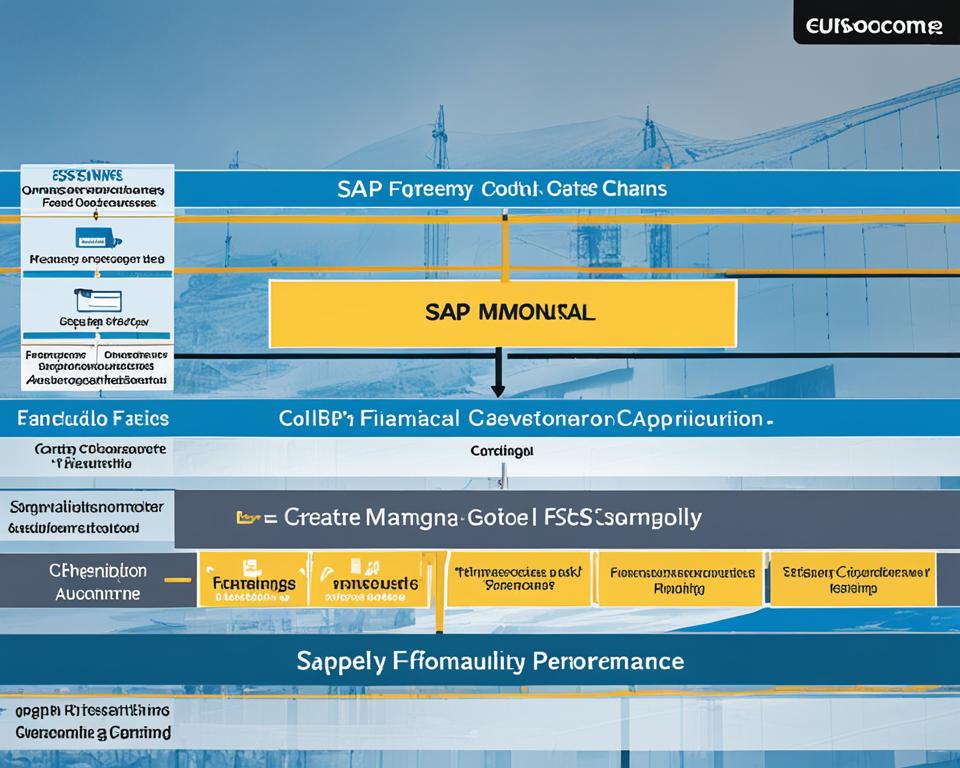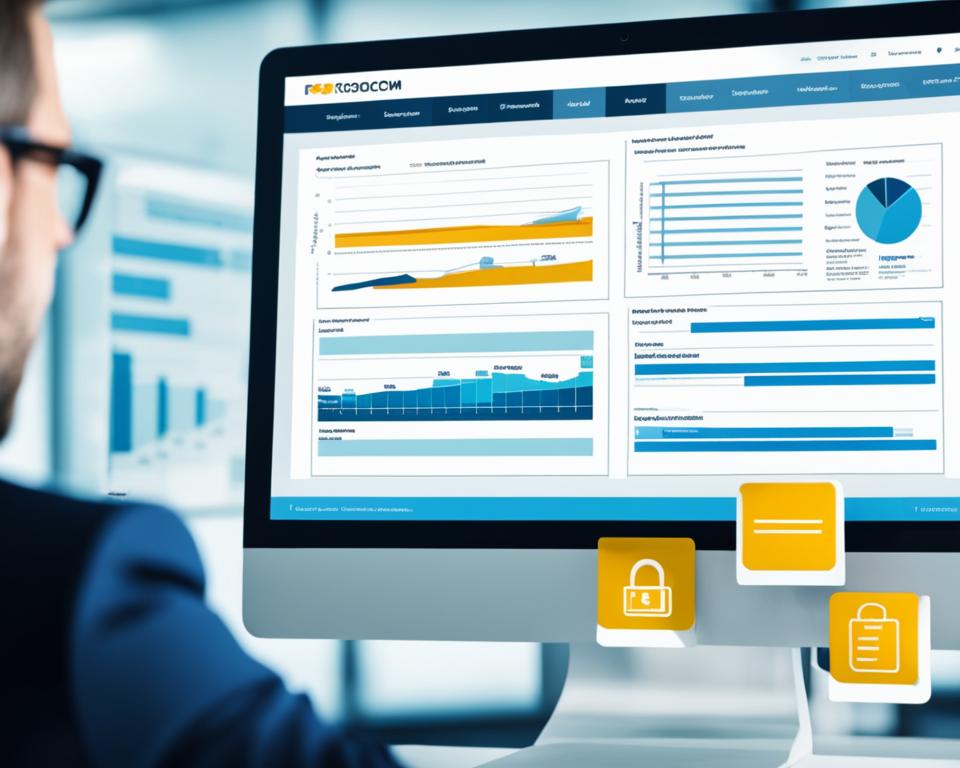Ever thought about how companies boost their finances and keep cash flowing smoothly? The secret is SAP FSCM (Financial Supply Chain Management). This tool makes managing cash easier and helps use working capital better. It also makes things more efficient. I’ve seen how SAP FSCM changes the game for companies wanting to manage cash better and improve their performance.
Exploring SAP FSCM shows how it changes financial workflows. It helps companies grow and stay stable in a tough market.
Key Takeaways
- SAP FSCM is key for better financial operations.
- It helps with managing cash flow and working capital.
- Streamlining processes makes things more efficient.
- Real-time monitoring helps with making quick decisions.
- Using SAP FSCM can speed up business growth.
Understanding Financial Supply Chain Management
Financial Supply Chain Management (FSCM) covers many key activities. It helps manage cash flow, reduce credit risk, and keep the supply chain liquid. The definition shows how FSCM links financial processes with operations. This helps businesses work better and save money.
Having good financial supply chain management is very important. Companies that focus on FSCM get better at what they do and make more money. Working closely with suppliers and customers also makes things run smoother and makes the company stronger financially.
Using technology, like SAP Ariba, makes FSCM even better. These tools make buying things easier and help keep track of money better. With technology, companies can make smart choices using the latest data. This makes FSCM key in today’s fast-paced world.
| Key Elements | Benefits |
|---|---|
| Cash Flow Management | Enhanced liquidity and financial stability |
| Credit Risk Assessment | Reduced chances of default and financial loss |
| Supplier Relationship Management | Stronger collaboration and transaction efficiency |
| Liquidity Planning | Better forecasting and resource allocation |
What is SAP FSCM?
SAP FSCM is a top-notch software solution aimed at boosting financial supply chain operations. It includes many applications that make financial processes smoother. This helps with managing cash better, assessing credit risks, and solving disputes easily.
This system brings together financial activities into one place. It helps with making better decisions and managing cash flow well. By doing this, companies can use their resources more wisely and stay financially healthy.

Benefits of Implementing SAP FSCM
Using SAP FSCM has big perks for companies, especially in managing cash and optimizing working capital. This solution helps improve financial operations. It makes companies more efficient and profitable overall.
Enhancement of Cash Management
Good cash management is key for staying liquid and financially stable. SAP FSCM offers better cash position visibility and control over cash flows. This lets companies make smart decisions with up-to-date data.
It helps use funds well, reducing cash shortfalls and making the most of surplus cash. With better processes, companies can collect money faster and have less in outstanding receivables. This leads to better cash management.
Improved Working Capital Optimization
Optimizing working capital helps cut costs and use resources better. SAP FSCM lets companies look at and improve accounts receivable and inventory processes. It also gives better data integration and reporting.
This helps spot and fix inefficiencies. Better working capital management means a stronger financial position. It’s good for growth and staying competitive. For more on how SAP FSCM can change things, check out the benefits of SAP FSCM.
Key Components of SAP FSCM
SAP FSCM has many important parts that work together to improve financial supply chain management. These parts help organizations manage their money better, especially in cash management, treasury, and risk management.
Cash Management Features
The cash management features in SAP FSCM help track and manage cash flows. They let businesses keep an eye on their cash, predict cash needs, and keep enough money on hand. This way, they can stick to their financial plans and avoid too much borrowing.
Treasury Operations Insights
SAP FSCM gives important insights into treasury operations. By looking at market trends and their own data, companies can make better investment choices. They can manage cash better and follow the law. This part makes treasury management more efficient by linking with other financial systems for quick access to important info.
Risk Management Capabilities
Managing risks is key in SAP FSCM. It helps companies spot, check, and lessen risks in cash and treasury areas. With tools for making scenarios and predicting market changes, companies can plan to reduce risks. This makes their finances stronger and more stable.

How SAP FSCM Enhances Cash Management
SAP Financial Supply Chain Management (FSCM) boosts cash management in companies. It lets businesses watch their cash flow in real-time. This gives a clear view of their financial health.
Real-Time Monitoring of Cash Positions
With SAP FSCM, I can quickly check my company’s cash levels. It updates fast and combines data from different departments. This leads to smarter decisions.
This real-time monitoring helps avoid cash problems and keeps finances stable. It lets me manage money well, keeping cash levels right.
Forecasting Cash Flow for Better Decisions
Forecasting cash flow is key to better cash management with SAP FSCM. It uses past data and trends to predict future cash. This cash flow forecasting helps plan for expenses and investments.
It makes strategic decisions easier. Companies using this feature can use resources better and tackle financial issues quickly. For more on how integration platforms help with finance, check out this resource.
| Feature | Benefit |
|---|---|
| Real-Time Monitoring | Immediate visibility of cash positions |
| Cash Flow Forecasting | Better resource allocation and planning |
| Advanced Analytics | Informed and strategic decision-making |
Working Capital Optimization Strategies
Improving working capital is key to a company’s financial health. This part looks at ways to make the most of accounts receivable and inventory. I’ll cover how to speed up collections and manage overdue invoices. Plus, I’ll share tips on keeping inventory levels right to save cash and cut costs.
Optimizing Accounts Receivable
To make accounts receivable better, I focus on quick collection processes. Automated reminders for overdue bills can cut down on waiting time. By looking at payment patterns and customer habits, I set credit terms that help customers pay on time. Checking on accounts receivable often helps spot slow payers and plan strategies for them, boosting cash flow.
Inventory Management Techniques
Good inventory management is key for working capital optimization. I use just-in-time (JIT) inventory to cut down on storage costs and keep products in stock. Forecasting demand and working with suppliers helps keep the right amount of inventory. Checking inventory turnover rates helps me see how well I’m managing inventory, making sure I use resources wisely to improve financial results.

SAP FSCM and Invoice Processing
Using SAP FSCM changes how companies handle invoices. Automation cuts down on manual work, making things run smoother. This means invoices get approved faster, speeding up the whole process.
SAP FSCM makes invoicing more accurate. Automation cuts down on mistakes, making sure invoices match what suppliers agree to. This leads to stronger relationships with suppliers. They like getting paid on time and having accurate invoices, which builds trust and teamwork.
Here are the main benefits of using SAP FSCM for invoices:
- Faster processing times for invoices, making things run smoother.
- Greater transparency in seeing where invoices are at, helping departments talk better.
- Reduction in paper usage, helping the planet.
The table below shows how traditional invoice processing compares to using SAP FSCM:
| Aspect | Traditional Invoice Processing | SAP FSCM Invoice Processing |
|---|---|---|
| Processing Time | Days or weeks | Hours or days |
| Error Rate | High (20% or more) | Low (1-2%) |
| Supplier Communication | Fragmented | Integrated and real-time |
| Environmental Impact | High (paper documents) | Low (digital documentation) |
By using SAP FSCM, companies can really improve how they handle invoices. This helps their finances and their relationships with suppliers a lot.
Dispute Management in SAP FSCM
Effective dispute management is key to SAP FSCM’s success. It helps solve conflicts quickly and smoothly. This keeps operations running smoothly, even when disagreements happen. Clear conflict resolution processes reduce disruptions and strengthen customer ties.
Streamlined Processes for Dispute Resolutions
SAP FSCM offers streamlined processes for handling disputes. Automated tools make managing complaints and queries easier, leading to faster solutions. The main benefits are:
- Centralized tracking of disputes for better visibility.
- Reduction in response times, leading to quicker resolutions.
- Automated notifications regarding dispute status, keeping stakeholders informed.
Impact on Customer Relationships
Keeping customer relationships strong during disputes is crucial. Good communication and a clear resolution process build trust. By actively engaging with customers, they feel important and heard. This approach leads to:
- Long-lasting customer loyalty.
- Improved satisfaction ratings.
- Stronger partnerships, which boosts overall business performance.
Using strong dispute management in SAP FSCM boosts efficiency and helps grow important customer relationships. For more on procurement practices, check out the SAP Ariba Modules context.

Credit Management Features in SAP FSCM
In the world of financial supply chain management, managing credit well is key. SAP FSCM offers strong tools to handle credit risk and improve cash flow. These tools are vital for keeping the business and its customers financially healthy.
Assessing Credit Risk
At the heart of SAP FSCM’s credit management is assessing credit risk. It uses detailed data analysis to check customers’ financial health and creditworthiness. This is key to lowering the risk of losses and making better credit decisions.
Setting Credit Limits for Customers
SAP FSCM also lets you set the right credit limits for customers after assessing their risk. This helps manage the risks of credit sales. It keeps the company’s finances safe and builds strong customer relationships. Setting limits wisely can boost cash flow and cut down on bad debt.
| Credit Risk Assessment Factors | Weight (%) | Considerations |
|---|---|---|
| Payment History | 30 | How often and on time customers pay. |
| Credit Score | 25 | How likely a customer is to pay back based on credit reports. |
| Financial Stability | 20 | Look at financial statements, cash flow, and liquidity ratios. |
| Industry Trends | 15 | How the economy and industry changes affect customers. |
| Customer Relationship | 10 | Trust built from past dealings. |
Compliance and SAP FSCM
SAP FSCM is key for companies to follow complex rules and laws. With more rules from different groups, having strong systems is vital. SAP FSCM gives the tools to meet these needs well.
Meeting Regulatory Requirements
Rules change often, so companies must stay flexible. SAP FSCM helps by automating tasks and keeping records right. This makes it easier to follow industry rules.
It makes sure all money dealings are recorded and easy to find. This shows a company’s effort to follow the law.
Auditing and Reporting Capabilities
Good auditing is crucial for following rules. SAP FSCM has built-in auditing tools for checking financial records. These tools help watch over money dealings closely.
They make sure everything follows the rules. Reporting tools also help by making reports that show how well a company is doing with compliance. Regular checks can spot problems early, helping to fix them fast.

Real-World Examples of SAP FSCM Implementation
Many companies have made SAP FSCM a key part of their financial supply chain management. These real-world examples show how different industries use this tool to boost their operations.
A leading retail chain used SAP FSCM to make managing cash easier. This helped them keep track of cash in real-time. It made their decision-making faster and more accurate.
This led to better control over inventory and more cash on hand.
Another company, a global manufacturer, chose SAP FSCM to improve accounts receivable. They set up better workflows for handling invoices. This cut down on outstanding accounts a lot.
Now, they have better forecasts and more cash flowing in.
In the tech world, a big software company used SAP FSCM to handle credit risks better. They did detailed assessments and set credit limits. This led to a big drop in overdue bills.
These case studies show how SAP FSCM can be used in many sectors.
Overall, using SAP FSCM brings many benefits. Companies see better cash management, more efficient working capital, and stronger financial stability. This proves the worth of this innovative solution.
How to Get Started with SAP FSCM
Starting with SAP FSCM means thinking about what you really need. First, pick the right SAP solutions for your business. Look at what will help your financial supply chain, like managing cash, checking credit risks, or sending invoices. Choosing the right tools is key to a successful start.
Choosing the Right SAP Solutions
When picking SAP solutions, get input from different departments. Finance, procurement, and others all play a big part in managing money and improving cash flow. Working together helps make sure we cover all bases. This way, we make a choice that really fits our needs and gets the most out of SAP FSCM.
Training and Support Resources
After picking the right SAP solutions, training is next. Teaching my team about SAP FSCM lets them use it to its fullest. Having ongoing education and tech support is vital for overcoming any hurdles. With great training resources, we can master and make the most of SAP FSCM.



Leave a Reply